Coupled Harmonic Oscillators Tutorial Sheet, Sheet #8
Learning targets
- Write down the equations of motion for a system
- Rewrite equations of motion in matrix form
- Find eigenvalues to solve for mode shapes
Additional Resources
Tutorials
- CHO Notes : Essentially the lecture notes, but rephrased.
- Walkthrough : Step-by-step tutorial that may push your thinking a bit.
Software
- Freddie’s Widget : A widget written by Freddie that shows the progression of oscillators!
Problem sheet
Skill Building Questions
Problem 1.
(a) Write down the equations of motion of the masses $m_1=2m$ and $m_2=m$, considering the spring constants $k_1=k_2=k$ and locations of the two masses $x_1$ and $x_2$, which are both zero when the system is in static equilibrium.
$\Rightarrow$ The equations of motion of the masses are: $$2m\ddot{x}_1+2kx_1-kx_2= 0 \\\ m\ddot{x}_2-kx_1+kx_2= 0$$
(b) Express these equations in matrix form with separate vectors containing only displacements and accelerations and determine the characteristic frequencies and the corresponding mode shapes.
Mode shape for $\omega_2 =\sqrt{\frac{k}{m}+\frac{1}{\sqrt{2}}\frac{k}{m}}$ : $$ \boxed{ \begin{bmatrix} \frac{1}{\sqrt{2}}\frac{k}{m} & \frac{k}{2m}\\\ \frac{k}{m} & \frac{1}{\sqrt{2}}\frac{k}{m} \end{bmatrix} \begin{bmatrix} A_1\\\ A_2 \end{bmatrix} = \begin{bmatrix} 0\\\ 0 \end{bmatrix}} $$ $\frac{1}{\sqrt{2}}A_1=-\frac{1}{2}A_2$, masses move in opposite directions.
Exam Style Questions
Problem 2.
The question above was fairly straightforward (not because it’s easy, but because it only has 2 masses). Here, we will be dealing with four masses - please don’t try to do this by hand. It’ll be much easier to use MATLAB. This is a clone of the 2020 exam question.
A one-dimensional system of 4 coupled harmonic oscillators (see below) of mass $m=6kg$ are connected in series by springs of stiffness $k=18Nm$ and to a wall at one end of the system but left unconstrained at the other end.

(a) Write down an expression for the acceleration of the first oscillator in the form $\ddot{x}_1=Ax_1+Bx_2$.
The general form for the acceleration of the $n$th mass is: $$m_n\ddot{x}_n=-k_n(x_n-x_{(n-1)})-k_{(n+1)}(x_n-x_{(n+1)})$$ We are interested in the first mass, so $n=1$. This also means that any $(n-1)$ terms are replaced with 0. We have: $m_1\ddot{x}_1=-k_1(x_1-0)-k_{2}(x_1-x_{2})$
$m_1\ddot{x}_1=-k_1x_1-k_2x_1+k_2x_2$
$\ddot{x}_1=\frac{-2k}{m}x_1+\frac{k}{m}x_2$
$\ddot{x}_1=\frac{-2\times18}{6}x_1+\frac{18}{6}x_2$ $\boxed{\ddot{x}_1=-6x_1+3x_2, A=-6, B=3}$
(b) Write down the matrix relating the positions to the accelerations of the four masses.
$$\begin{pmatrix} -6 & 3 & 0 & 0\\ ? & ? & ? & ?\\ ? & ? & ? & ?\\ ? & ? & ? & ? \end{pmatrix}$$
The next line can be found by constructing the equation for $\ddot{x}_2$, and so on - remembering either to construct the equations from first principals each time, or to apply the above general equation correctly: if spring or mass $n+1$ or $n-1$ does not exist, use 0 as its value. $$m_n\ddot{x}_n=-k_n(x_n-x_{(n-1)})-k_{(n+1)}(x_n-x_{(n+1)})$$ $$m_2\ddot{x}_2=-k_2(x_2-x_1)-k_3(x_n-x_3)$$ $$\ddot{x}_2=3x_1-6x_2+3x_3$$ $$\boxed{ \begin{pmatrix} -6 & 3 & 0 & 0\\ 3 & -6 & 3 & 0\\ 0 & 3 & -6 & 3\\ 0 & 0 & 3 & -3 \end{pmatrix}x=\ddot{x}}$$
(c) How many natural frequencies does this system have?
We can verify this very easily using MATLAB of Wolfram: the number of eigenvalues = the number of natural frequencies.
In MATLAB, type
eigs[matrix]
eigenvalues (your-matrix-here)
MATLAB:
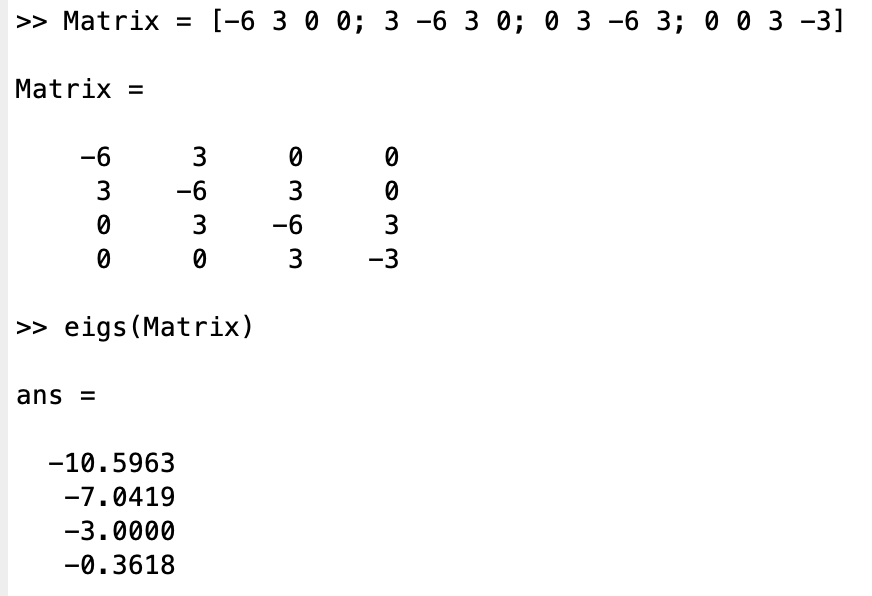 (MATLAB tends to be easier and quicker for matrix operations than Wolfram, but both will work.)
(MATLAB tends to be easier and quicker for matrix operations than Wolfram, but both will work.)
(d) Find the period of oscillation of the vibrational mode at which all the oscillators are out of phase with their immediate neighbours, to 1 significant figure.
[vectors, values] = eigs(Matrix)
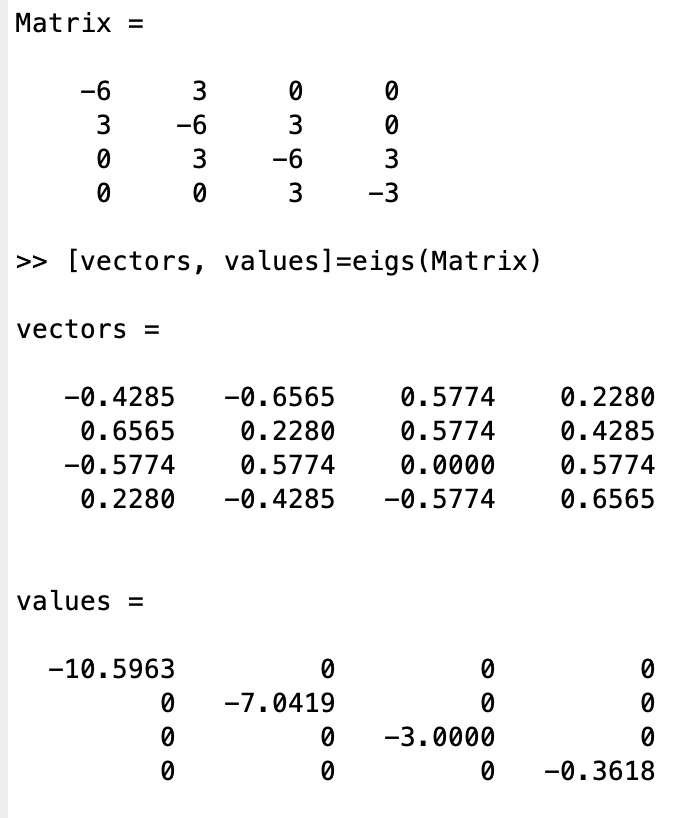 We can see from the vectors that the eigen mode which satisfies the question is the 1st one, as each mass has a different sign to its neighbours.
From our knowledge of eigen analysis, we know that $\lambda=-\omega^2$, so to find $\omega$ from our eigenvalue, we have to take $\omega=\sqrt{-value}$.
We can see from the vectors that the eigen mode which satisfies the question is the 1st one, as each mass has a different sign to its neighbours.
From our knowledge of eigen analysis, we know that $\lambda=-\omega^2$, so to find $\omega$ from our eigenvalue, we have to take $\omega=\sqrt{-value}$.
 In the above code, we take the first eigenvalue, which we have identified as the one we need, and use it to calculate the corresponding $\omega$.
In the above code, we take the first eigenvalue, which we have identified as the one we need, and use it to calculate the corresponding $\omega$.
$\Rightarrow \omega=3.2552$
We now need to convert this into a time period.
$\omega=\frac{2\pi}{t} \therefore t=\frac{2\pi}{\omega}=1.9302s$
$\Rightarrow \boxed{t=2s (1s.f.)}$
(e) If a 5th similar spring were added to this system, connecting the final oscillator to another wall, what would you expect this to do to the resonant frequencies of the system?
$$\begin{pmatrix} -6 & 3 & 0 & 0\\ 3 & -6 & 3 & 0\\ 0 & 3 & -6 & 3\\ 0 & 0 & 3 & -6 \end{pmatrix}$$
Then we repeat the MATLAB eigen analysis.
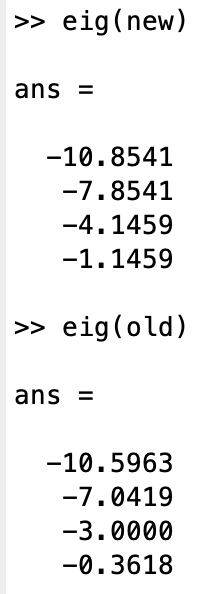 We can see that the new eigenvalues are slightly larger than the old ones.
We can see that the new eigenvalues are slightly larger than the old ones.
$\Rightarrow \boxed{\text{The resonant frequencies all increase}}$
Problem 3.
A 16-coach train is rolling down a hill.
The coaches can be modelled as coupled harmonic oscillators, each with mass $m=6.5\times10^3kg$ and connected by springs with spring constant $k=300Nm$. Every 15 seconds, the train passes an electricity pylon next to the track. The aerodynamic effect of these pylons begin to cause the coaches of the train to oscillate. If this oscillation frequency matches any of the natural frequencies of the train, it will begin to resonate at higher and higher amplitudes and eventually break apart.
The general diagram of this system looks exactly like the diagram above, without the wall and with 16 masses instead of 4.
By calculating the time periods of the natural frequencies of the system to the nearest second, decide if this wil be a problem.
Note: This will be a problem if the time period between pylons ($=15s$) = the time period of any of the natural frequencies.
To solve this, we will:
- Find the eigenvalues of the system
- Convert these to omega values
- Convert these to the natural time periods
- Check to see if any of the above = 15s.
We can construct a stiffness matrix for the train, as in previous questions. Note that there are no couplings at either end (the train is free to move).
$$\begin{pmatrix} -\frac{3}{65} & \frac{3}{65} & 0 & 0 & 0 & 0 & 0 & 0 & 0 & 0 & 0 & 0 & 0 & 0 & 0 & 0\\ \frac{3}{65} & -\frac{6}{65} & \frac{3}{65} & 0 & 0 & 0 & 0 & 0 & 0 & 0 & 0 & 0 & 0 & 0 & 0 & 0\\ 0 & \frac{3}{65} & -\frac{6}{65} & \frac{3}{65} & 0 & 0 & 0 & 0 & 0 & 0 & 0 & 0 & 0 & 0 & 0 & 0\\ 0 & 0 & \frac{3}{65} & -\frac{6}{65} & \frac{3}{65} & 0 & 0 & 0 & 0 & 0 & 0 & 0 & 0 & 0 & 0 & 0\\ 0 & 0 & 0 & \frac{3}{65} & -\frac{6}{65} & \frac{3}{65} & 0 & 0 & 0 & 0 & 0 & 0 & 0 & 0 & 0 & 0\\ 0 & 0 & 0 & 0 & \frac{3}{65} & -\frac{6}{65} & \frac{3}{65} & 0 & 0 & 0 & 0 & 0 & 0 & 0 & 0 & 0\\ 0 & 0 & 0 & 0 & 0 & \frac{3}{65} & -\frac{6}{65} & \frac{3}{65} & 0 & 0 & 0 & 0 & 0 & 0 & 0 & 0\\ 0 & 0 & 0 & 0 & 0 & 0 & \frac{3}{65} & -\frac{6}{65} & \frac{3}{65} & 0 & 0 & 0 & 0 & 0 & 0 & 0\\ 0 & 0 & 0 & 0 & 0 & 0 & 0 & \frac{3}{65} & -\frac{6}{65} & \frac{3}{65} & 0 & 0 & 0 & 0 & 0 & 0\\ 0 & 0 & 0 & 0 & 0 & 0 & 0 & 0 & \frac{3}{65} & -\frac{6}{65} & \frac{3}{65} & 0 & 0 & 0 & 0 & 0\\ 0 & 0 & 0 & 0 & 0 & 0 & 0 & 0 & 0 & \frac{3}{65} & -\frac{6}{65} & \frac{3}{65} & 0 & 0 & 0 & 0\\ 0 & 0 & 0 & 0 & 0 & 0 & 0 & 0 & 0 & 0 & \frac{3}{65} & -\frac{6}{65} & \frac{3}{65} & 0 & 0 & 0\\ 0 & 0 & 0 & 0 & 0 & 0 & 0 & 0 & 0 & 0 & 0 & \frac{3}{65} & -\frac{6}{65} & \frac{3}{65} & 0 & 0\\ 0 & 0 & 0 & 0 & 0 & 0 & 0 & 0 & 0 & 0 & 0 & 0 & \frac{3}{65} & -\frac{6}{65} & \frac{3}{65} & 0\\ 0 & 0 & 0 & 0 & 0 & 0 & 0 & 0 & 0 & 0 & 0 & 0 & 0 & \frac{3}{65} & -\frac{6}{65} & \frac{3}{65}\\ 0 & 0 & 0 & 0 & 0 & 0 & 0 & 0 & 0 & 0 & 0 & 0 & 0 & 0 &\frac{3}{65} & -\frac{3}{65} \end{pmatrix}$$
The matrix is also huge, and therefore evil to type into MATLAB.
 Then the omega values:
Then the omega values:
 To find the natural time periods, we use the fact that $\omega=\frac{2\pi}{t}$, so $t=\frac{2\pi}{\omega}$.
We have to use a . in the MATLAB code here, because we want it to perform the operation on each of the elements of the array, and not on the array as a whole.
To find the natural time periods, we use the fact that $\omega=\frac{2\pi}{t}$, so $t=\frac{2\pi}{\omega}$.
We have to use a . in the MATLAB code here, because we want it to perform the operation on each of the elements of the array, and not on the array as a whole.
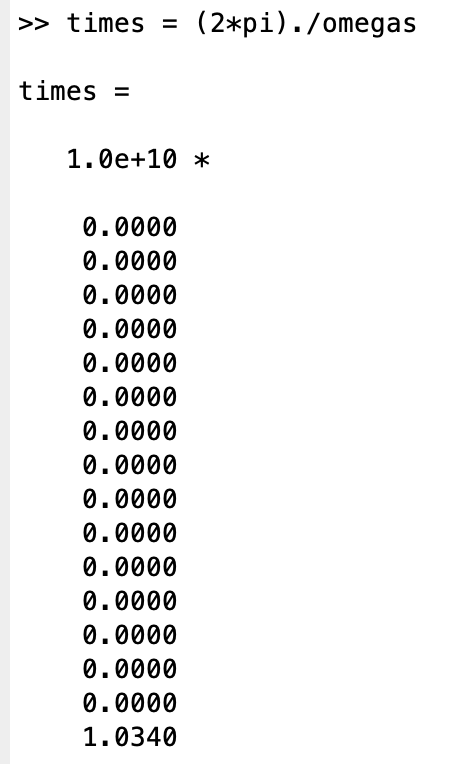 This is frustrating, because it is displaying the array in standard form, in order to be able to display the last one. We need to know the integer values, not in standard form. In order to correct this, we need to use:
This is frustrating, because it is displaying the array in standard form, in order to be able to display the last one. We need to know the integer values, not in standard form. In order to correct this, we need to use:
format shortG
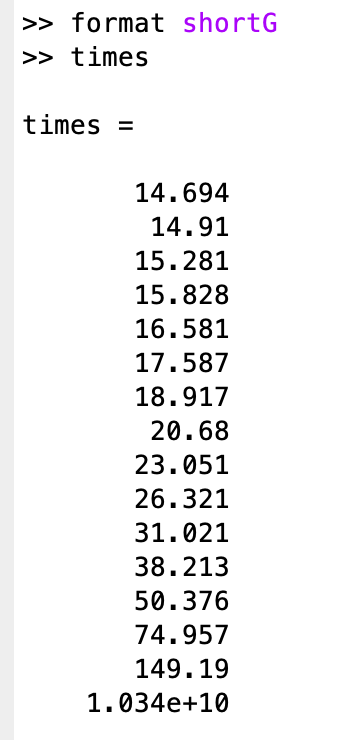 We can now see that the first 3 of these times round to 15 seconds, to the nearest second. This means that the pylons are driving the oscillation of the train at it's natural frequency.
We can now see that the first 3 of these times round to 15 seconds, to the nearest second. This means that the pylons are driving the oscillation of the train at it's natural frequency.
$\Rightarrow \boxed{\text{There will be a problem. The effect of the pylons will be to cause the train to resonate.}}$
*Incidentally, it was exactly this sort of resonance problem that caused the Tacoma Narrows bridge collapse (video).
Extension Question
Problem 4.
The below is a stiffness matrix for a series of 3 masses connected to each other and a wall at each end by 4 springs.
\[\begin{pmatrix} -3 & 2 & 0\\ 1 & -4 & 3\\ 0 & 2 & -6 \end{pmatrix}\](a) Calculate what each of the masses $m_1\rightarrow{}m_3$ and spring constants $k_2\rightarrow{}k_4$ must be, in terms of $k_1$
$$\begin{pmatrix} -\frac{k_1+k_2}{m_1} & \frac{k_2}{m_1} & 0\\ \frac{k_2}{m_2} & -\frac{k_2+k_3}{m_2} & \frac{k_3}{m_2}\\ 0 & \frac{k_3}{m_3} & -\frac{k_3+k_4}{m_3} \end{pmatrix}$$
Then, we can equate this to the original stiffness matrix:
$$\begin{pmatrix} -\frac{k_1+k_2}{m_1} & \frac{k_2}{m_1} & 0\\ \frac{k_2}{m_2} & -\frac{k_2+k_3}{m_2} & \frac{k_3}{m_2}\\ 0 & \frac{k_3}{m_3} & -\frac{k_3+k_4}{m_3} \end{pmatrix}=\begin{pmatrix} -3 & 2 & 0\\ 1 & -4 & 3\\ 0 & 2 & -6 \end{pmatrix}$$
So, therefore:
$$ \frac{k_1+k_2}{m_1}=3, \quad \frac{k_2}{m_1}=2\\ \frac{k_2}{m_2}=1, \quad \frac{k_2+k_3}{m_2}=4, \quad \frac{k_3}{m_2}=3\\ \frac{k_3}{m_3}=2, \quad \frac{k_3+k_4}{m_3}=6 $$
Plugging these equations into Wolfram (link) gives us that:
$\Rightarrow \boxed{k_2=2k_1, k_3=6k_1, k_4=12k_1, m_1=k_1, m_2=2k_1, m_3=3k_1 \text{ where } k_1\not=0}$
Note that Wolfram can be a bit picky about simultaneous equations and that the above link may sometimes not work. Try typing it in yourself:
(k_1 + k_2) / m_1 = 3, k_2 / m_1 = 2, etc...
(b) What integer-value of $k_1$ will yield the smallest natural frequency of the system?
This means its eigenvalues (and thus the natural frequencies) are unaffected.
(c) We connect mass $m_3$ to a wall using spring $k_4$, and ignore all other components of the original setup. Draw this new setup.
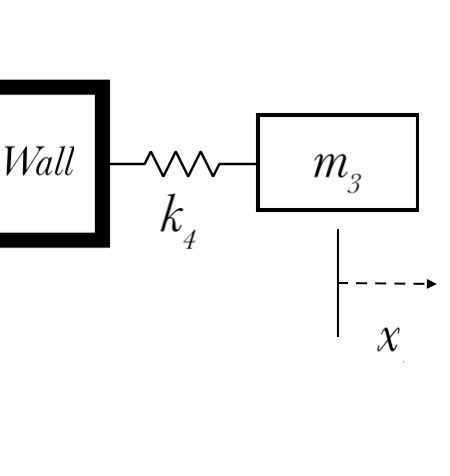
(d) Assuming a damping constant of $c=24$, and that this new oscillator is critically damped, use your knowledge of ODEs to find the value of $k_1$ and thus the values of all the springs and masses.
For a critically damped oscillator, we know that the determinant is 0, i.e. $\sqrt{c^2-4\times{}m_3\times{}k_4}=0$.
$\sqrt{24^2-4\times3k_1\times12k_1}=0$
$24^2=4\times3k_1\times12k_1$
$576=144k_1^2$
$k_1^2=4$
$\Rightarrow \boxed{k_1=2Nm}$
From this, you can work out that $k_2=4$, $k_3=12$, $k_4=24$ and $m_1=2$, $m_2=4$, $m_3=6$.
Answers
For Printing